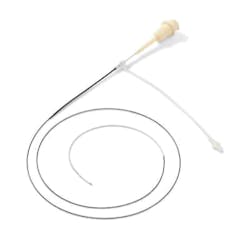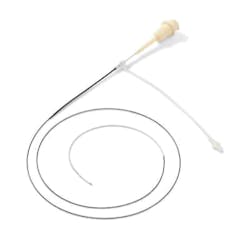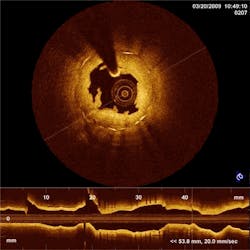It isn’t surprising that lasers would rule Photonics West 2010—especially since 2010 marks the official 50th anniversary of the laser. From the dazzling display of laser lights, laser magicians, and video of James Bond’s scrape with an industrial laser in Goldfinger at the all-conference “Cirque du Lasaire” reception on Monday night, to the historic laser display in the North Hall exhibit area from Tuesday through Thursday, to the impressive National Ignition Facility tour for those lucky few on Thursday afternoon, lasers were indeed the talk of San Francisco during SPIE’s Photonics West 2010 conference. Held January 23 to 28 for the first time at The Moscone Center, the larger venue was required to keep pace with (and provide space for) the whopping 18,327 attendees—up 2.5% from last year.
Saturday night hot spot
While Saturday night may seem an atypical time for a series of technology presentations, the packed room at the Photonics West Biomedical Optics (BiOS) symposium hot topics session from 7 to 9 pm on Saturday, January 23 showed just how “hot” the biomedical optics and photonics community has become. Some 860 or so individuals listened to ten researchers present the latest developments in this field.In “Breast Cancer Therapy,” Nirmala Ramanujam from Duke University (Durham, NC) opened with the staggering statistic that 1.5 million women are diagnosed with breast cancer annually, with a third of those succumbing to death, usually due to cancer metastases. Ramanujam hopes that a combination of Raman and fluorescence spectroscopy (which can each see different materials like collagen and muscle) can improve intra-operative assessment of cancer and aid in removal of growths or cancerous tissue before they spread to other parts of the body.
Besides cancer, heart disease is another ruthless killer. Joseph Schmitt, CTO of LightLab Imaging (Westford, MA), explained in the next talk how “Intravascular OCT Extends Reach to Clinical Practice” using a MEMS tunable laser developed by Axsun (Billerica, MA) and licensed by LightLab. The source is used in a Fourier-domain intra-coronary optical-coherence-tomography (OCT) system that can image in the blood field of a beating heart using a novel imaging device (see figure).
Brian Pogue from Dartmouth College (Hanover, NH) spoke on “Diffuse Molecular Imaging: Detecting Invisible Changes In Vivo” and described the huge market potential of image-guided optical molecular spectroscopy.
With 178 BiOS exhibiting companies, Photonics West in total showcased 1142 exhibiting companies and hosted 3600 paper presentations. Just following the weekend BiOS activities, a good place to begin the rest of the week was the Monday Lasers & Photonics Marketplace Seminar (www.marketplaceseminar.com), held in conjunction with Photonics West each year and providing a comprehensive overview of the “State of the Laser Industry” from a market and technology perspective.
Pulse of the laser markets
Attendees to this year’s Lasers & Photonics Marketplace Seminar hopefully found the trek from The Moscone Center to the Hilton San Francisco Union Square less painful upon hearing Steve Anderson, chief editor of Laser Focus World, and David Belforte, chief editor of Industrial Laser Solutions, tell the audience that the worst of the 2009 laser industry downturn seemed to be over. Although the 2009 forecast called for an 11.3% drop in the overall laser markets, the actual 2009 drop was a dismal 24.1%; fortunately, the 2010 projection is for an 11.1% increase in laser sales worldwide--a welcome relief considering the gloom and doom of last year.
The Seminar program then moved ahead to focus on the resiliency of the laser industry, highlighting the many laser “inventions” that continue to keep the market alive: Lasers for igniting fusion to fulfill the energy needs of the next generation (a talk on the National Ignition facility by former astronaut Jeff Wisoff of Lawrence Livermore National Laboratory); moving from CO2 lasers for materials processing to today’s quantum-cascade lasers for homeland security and drug discovery (a presentation by Pranalytica CEO and Bell Labs alumnus Dr. C. Kumar N. Patel); lasers for flow and image cytometry in biomedical research (presented by William Telford from the National Cancer Institute); and, among other presentations, green lasers for multitudes of applications in bio-optics and imaging and displays (a technology forum on green laser diodes, green fiber lasers, green DPSS and optically pumped semiconductor lasers, green disk lasers, and other laser types from representatives of Trumpf, Newport Spectra-Physics, IPG Photonics, Nufern, Coherent, and newcomer Kaai).
Red, blue, and yes green
And speaking of green lasers, the Marketplace Seminar wasn’t the only place they were being discussed. In the Tuesday morning OPTO Plenary (Conferences this year were again labeled BiOS, OPTO, LASE, and MOEMS-MEMS), UCSB’s Shuji Nakamura, pioneer of violet and blue laser diodes based on nonpolar and semi-polar gallium nitride (GaN) materials, discussed how his research laid the groundwork for a new 523 nm green laser diode just developed by Kaai.
Nakamura’s talk took on a more-than-technology tone when he explained how the U.S. needs to ban the incandescent light bulb and focus on LED lighting. He says that Panasonic already has a 60 W equivalent incandescent bulb in the form of a 6.9 W LED bulb that costs $50; however, Panasonic is targeting half that price in 2010. Nakamura thinks that LED bulbs will be commonplace in a few years, assuming prices can come down rapidly.
More than lasers
But we all know that Photonics West is about much more than just lasers. Another big technology story in 2009 was the rise of solar photovoltaic (PV) energy. Yes, lasers are used in solar-cell materials processing, but the actual PV materials themselves (and the concentrating optics) are the big news for the photonics industry. The Tuesday afternoon Industry Events session entitled “Hot Markets in Photonics: Solar” was a very business-oriented session in which the first presenter Paula Mints, principal analyst at Navigant Consulting, pointed out that solar energy has been growing at a compound annual growth rate of 40% from 1974 to 2009, with prices falling from $9/W peak in 1983 to $2-$3/W peak in 2009 (but still far above the sub-$1 figures needed to replace conventional energy sources).
The next 50 years
Walking around the conference reception and the exhibit floor, there were many younger faces among the old timers; here’s hoping that the laser innovations of these new faces will bring us 50 more years of lasers and carry those old timers comfortably into retirement!
About the Author

Gail Overton
Senior Editor (2004-2020)
Gail has more than 30 years of engineering, marketing, product management, and editorial experience in the photonics and optical communications industry. Before joining the staff at Laser Focus World in 2004, she held many product management and product marketing roles in the fiber-optics industry, most notably at Hughes (El Segundo, CA), GTE Labs (Waltham, MA), Corning (Corning, NY), Photon Kinetics (Beaverton, OR), and Newport Corporation (Irvine, CA). During her marketing career, Gail published articles in WDM Solutions and Sensors magazine and traveled internationally to conduct product and sales training. Gail received her BS degree in physics, with an emphasis in optics, from San Diego State University in San Diego, CA in May 1986.


